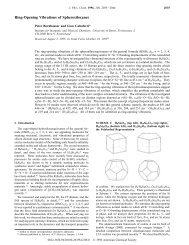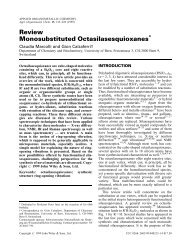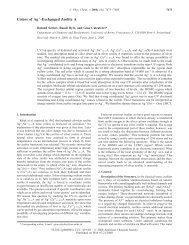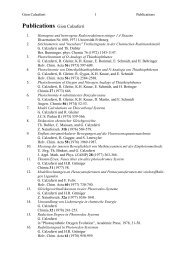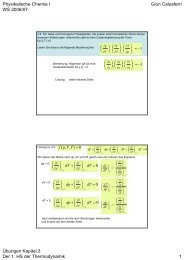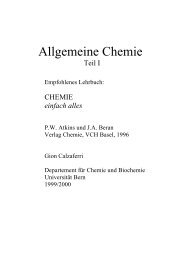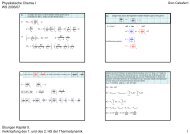Photonic antenna system for light harvesting
Photonic antenna system for light harvesting
Photonic antenna system for light harvesting
You also want an ePaper? Increase the reach of your titles
YUMPU automatically turns print PDFs into web optimized ePapers that Google loves.
Fig. 3 Simplified view of a bi-directional photonic <strong>antenna</strong>. The middle<br />
part shown in <strong>light</strong> grey contains donor molecules D. After excitation<br />
of D to D* the excitation energy migrates with equal probability to the<br />
left and to the right until it reaches an acceptor A (dark grey) which<br />
captures the excitation energy and emits it as red-shifted <strong>light</strong>.<br />
Fig. 4 a) EM pictures of the investigated zeolite L samples with<br />
different mean crystal lengths l cyl: A, 300 nm; B, 500 nm; C, 850 nm; D,<br />
1400 nm; E, 2400 nm (the bars in A–D correspond to 1 mm, in E to<br />
3 mm). b) Fluorescence intensity (scaled to the same height at the<br />
maximum of the Py z emission) of Py z -loaded and Ox z modified<br />
zeolite L crystals with constant Py z loading (ppy~0.11) as a function of<br />
crystal length after specific excitation of only Py z at 460 nm. The Ox z<br />
modification was, on average, two molecules at both ends of each<br />
channel. 5<br />
trapping rate is proportional to the gradient of the excitation<br />
distribution at the position of the acceptors. Hence, it depends<br />
not only on the remaining excitation probability but also on<br />
the excitation distribution. This is in contrast to the donor<br />
fluorescence rate, which depends only on the excitation distribution<br />
of the donors. The fluorescence rate of the acceptors<br />
is proportional to their excitation probability. We there<strong>for</strong>e<br />
expect a fluorescence decay behaviour as illustrated in Fig. 5b).<br />
The fluorescence decay of the donors becomes much faster<br />
in the presence of acceptors, because of the depopulation<br />
due to the irreversible energy transfer to the acceptors. The<br />
Fig. 6 a) Principle of a bi-directional three-dye photonic <strong>antenna</strong>. The<br />
enlarged section shows the organisation of individual dye molecules at<br />
the domain boundary between dye2 and dye3. b) Fluorescence<br />
microscopy images of an Ox z ,Py z ,POPOP–zeolite L crystal of<br />
2000 nm length upon selective excitation of A POPOP at 330–<br />
385 nm, B Py z at 470–490 nm, and C Ox z at 545–580 nm. The<br />
excitation <strong>light</strong> was eliminated by appropriate cut-off filters in front of<br />
the CCD-camera: A 410 nm, B 515 nm, C 605 nm.<br />
fluorescence intensity stemming from the acceptors initially<br />
increases because excited states must first be populated via<br />
energy transfer from the donors. It there<strong>for</strong>e reaches a maximum<br />
be<strong>for</strong>e it decays.<br />
A sophisticated bi-directional <strong>antenna</strong> material with three<br />
dyes is illustrated in Fig. 6. 4 After selective excitation of dye1,<br />
located in the middle part, the <strong>light</strong> energy is carried spectrally<br />
from the blue to green (dye2) to red (dye3) and spatially from<br />
the crystal centre to its left and right ends. The stacking of the<br />
dyes in the crystal can be seen in microscopy images taken on<br />
relatively large crystals (Fig. 6b)). We show this <strong>for</strong> a 2000 nm<br />
crystal with POPOP in the middle, followed by Py z and then<br />
by Ox z . The different colour regions which can be observed in<br />
this experiment are impressive. Image A shows the fluorescence<br />
observed after selective excitation of the POPOP. The middle of<br />
the crystal shows the blue fluorescence of POPOP while the red<br />
emission of Ox z appears at both ends. Between these two<br />
zones the superposition of the fluorescence of all three dyes<br />
results in emission of white <strong>light</strong>. In image B the fluorescence is<br />
shown after selective excitation of the Py z . The red emission,<br />
hardly visible at both ends, and the green emission stem from<br />
the Ox z and the Py z , respectively. The yellow emission is due<br />
to superposition of the green and red fluorescence. Image C<br />
shows the emission of Ox z after selective excitation of only<br />
Fig. 5 a) Excitation distribution along the channel axis of a zeolite L crystal consisting of 90 slabs (occupational probability p~0.3) under the<br />
condition of equal excitation probability at t~0 calculated <strong>for</strong> front–back trapping. Fluorescence of the donors is taken into account. A: t~5 ps, B:<br />
t~10 ps, C: t~50 ps, and D: t~100 ps after irradiation. b) Fluorescence decay of the donors in the absence of acceptors (dotted), in the presence of<br />
acceptors at both ends (solid), and fluorescence decay of the acceptors (dashed).<br />
4 J. Mater. Chem., 2002, 12, 1–13





